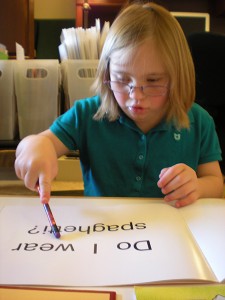READING: GET TO THE POINT…USE A POINTER!
The Best Little Tool
This one’s indispensable in the teaching toolbox: an unsharpened pencil, one for you and one for your child. I collect “pointers” of wild kinds: with footballs, soccer balls, halloween monsters, sparkling hearts (guess which gender prefers those), etc. I make a big deal of the child choosing a pointer for the reading lesson, as part of my “you have choices when you’re with me!” plan.
What’s the Point?
Here’s why it is so useful to have your child use a pointer (eraser tip touches the paper) and for YOU to use a pointer as you sit across from your child. (“What? Can’t I sit beside my child when I teach him/her?” No. I’ll explain later.) Pointer advantages:
- You know where your child’s eyes are.
- You know if they’re following the words correctly–or not.
- You can easily re-direct their pointer when needed.
- Your own pointer keeps them on track as they learn the vocabulary.
- It helps the child focus.
- It keeps little hands busy.
- It keeps the child correctly distanced from the book.
- It avoids the “nose-to-paper” distancing which so easily becomes a fixed (bad) habit.
- It avoids “finger dependency”; it’s easier to toss a pointer away eventually than to toss away a finger.
- It keeps things impersonal re: the teacher’s guidance; who likes to have someone else’s finger in their face? Much more fun to have Dora the Explorer point the way than mom’s finger.
“Teacher” Sits Across From “Student”
Here’s why I suggest you sit across from your child rather than side-by-side when teaching:
- You need to see their eyes! Nothing is more important when we’re teaching our children with Down syndrome. Focus is often a problem, and we need to know if the attention is wandering elsewhere so we can redirect it ASAP.
- You stay out of their space; this becomes increasingly important as your child gets older.
- By sitting across from your child in a “teaching position,” you help your child make a distinction between “Mommy the teacher” and “Reading Mommy” who reads awesome books aloud every night while snuggling in bed together.
Head For The Hills
…or Staples or Walmart or wherever and scout out some really cool pointers for Reading Time!
Cheers,



My child’s eye doctor has referred my son to Scottish Rites to discern if he has Dsyslexia. It’s been in back of my mind wondering. I have looked for research on Dyslexia and Down syndrome and found nothing. Interested in thoughts.
Hi, Donna- Another parent recently asked me a related question. As far as I know, it is entirely possible for a child to have both DS and Dyslexia, and I’m glad you’re following up with Scottish Rites. There may be a much higher incidence of that dual diagnosis than we know, because testing our children may be difficult in some cases. My thought is that it is possible that reading delays (when DS-specific teaching methods have failed) are due in many cases to Dyslexia rather than to short term memory problems, vision problems, etc. I would be interested to know what the Scottish Rites evaluation shows for your son.